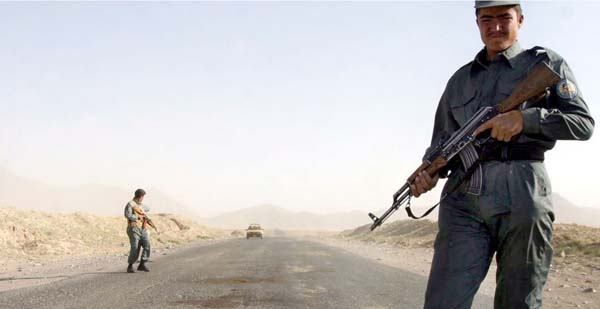Do you think that decapitating a number of men in cold blood is a movie’s denouement? What about the bitter tears rolling down a woman’s cheeks for the loss of her son? Won’t you be frozen with fright to see the hot drops of blood oozing from a beheaded body? But I watched such a nightmarish scene in my real life, albeit I was livid with fear and hatred. A taut look appeared on the wan faces of my friends, who saw a headless body on the side of a road when our vehicle passed the Maidan Wardak province. The women grimaced nauseously with hatred and nervousness. Our hearts were beating uncontrollably. A shiver ran down my spine, and I thought that we were spending the last moments of our life. All the travelers fell silent and motionless as a statue and perhaps everybody was imaging their past which elapsed in the blink of an eye. No one dared breathe a word.
The lumpy shapes of rocks and woods looked like an armed man going to shoot at us and the road appeared as a hungry dragon going to devour us soon. We were deep in disappointment. “What if an armed man appear on our way and order us to get off”, I asked under my breath. The pictures of hirsute militants, who searched me on the way to Ghazni province few months ago, flashed through my head. A thousand and one questions of such ilk arose in my mind.
The man was beheaded by the Taliban militants – who search the travelers every once in a while and murder those who are reported or suspected of working with government or NGOs. Therefore, people lose their lives without being involved in crime.
“I believe that the perception caused by civilian casualties is one of the most dangerous enemies that we face.” These words were spoken in 2009 by then International Security Assistance Force commander, Gen Stanley McChrystal.
They are quoted again at the beginning of a report produced by a group called Physicians for Social Responsibility in collaboration with two others.
The report, entitled Body Count: Casualty Figures after 10 years of the ‘War on Terror’ — Iraq, Afghanistan, Pakistan, begins with what has been one of the most ignored aspects of the conflict: the fact that the US and international forces have made great efforts at counting their own bodies, but few such attempts have been made to count the total number of others killed in this decade of conflict.
Citing an example of a German air strike in the Kunduz province, the report cites how a passive investigation reported only that 56 Taliban had been killed. When an active investigation was carried out, it was discovered that there had been in fact a 100 civilian casualties from the strike.
The term ‘passive’ refers to the limiting of casualties to those reported by “news agencies, hospital registers, police records, etc”. As opposed to this, “active methods”, such as the ones used by the report, “try to determine all victims in a certain area by investigations on the spot, e.g. by asking families after relatives have been killed”.
“The new system of counting bodies produces alarming results. The casualties are not just a few hundred or a few thousand more, but a staggering hundreds of thousands more. In Iraq, the report estimates, the number of civilian casualties between the 2003 and 2012 invasion have been close to a million, or 5pc of Iraq’s total population. Furthermore, according to the report, nearly 220,000 civilians have died in Afghanistan and 80,000 in Pakistan…. Yemen now stands poised to be inducted into this club of hapless nations. Whether it is by dereliction or design, a failure to count the dead does not in turn eliminate the wounds they leave behind on the body politic from whence they are wrest.”
In Afghanistan, only in the first three months of 2015, civilian casualties from ground engagements rose by eight per cent compared to the same period in 2014. Ground fighting between pro-government forces and anti-government elements caused 521 civilian casualties, with 136 civilians killed and 385 injured.
Total civilian deaths and injuries in the first quarter of 2015 followed the record high levels of 2014. Between 1 January and 31 March, UNAMA documented 1,810 civilian casualties (655 deaths and 1,155 injured), a two per cent decrease from the same period in 2014.
The civilian casualties and abductions have disseminated great fear among the Afghans, especially among the travelers. The unknown fate of the 31 passengers, abducted in Zabul province more than two months ago, augments travelers’ worries more than ever before. They fear to encounter the unlucky fate of the abductees.
It was not adventure of me but I was compelled to travel in the throes of war going on between the government forces and the Taliban’s ragtag militants. When a bullet struck our vehicle in Nani, aa close to Moqor District, the travelers’ faces turned pale but we were fortunate enough to survive. Such incidents pale into insignificance when you see the head of an unlucky man cut and thrown on a side of a road. Whenever I intend to travel, I notice my mother’s nervousness and anxiety and I realize what the pain and anguish my family, especially my mother, would suffer if I be abducted or lose my life. But I believe that my fate may not play nicely forever and I will be one of the victims as my compatriots – many other citizens think the same. Hope the national and international forces realize the pains being inflicted upon our nation and adopt a strong strategy to end terrorism.

